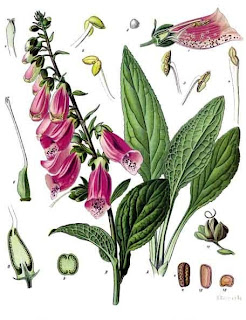Digitalis purpurea - Purple Foxglove - Yet another poison plant said to be part of a witch's garden. Foxglove
 is extremely poisonous, it contains digitalis glycosides. Atropine is not an antidote. Due to the presence of the cardiac glycoside digitoxin, the leaves, flowers and seeds of this plant are all poisonous to humans and some animals and can be fatal if eaten. The leaves of the upper stem are particularly potent, with just a nibble being enough to potentially cause death. The Digitalis purpurea extract, called "Digitalin," is used for the treatment of heart conditions. The scientific name means "finger-like" and refers to the ease with which a flower of Digitalis purpurea can be fitted over a human fingertip.
is extremely poisonous, it contains digitalis glycosides. Atropine is not an antidote. Due to the presence of the cardiac glycoside digitoxin, the leaves, flowers and seeds of this plant are all poisonous to humans and some animals and can be fatal if eaten. The leaves of the upper stem are particularly potent, with just a nibble being enough to potentially cause death. The Digitalis purpurea extract, called "Digitalin," is used for the treatment of heart conditions. The scientific name means "finger-like" and refers to the ease with which a flower of Digitalis purpurea can be fitted over a human fingertip.
There have been instances of people confusing digitalis with comfrey (Symphytum) with fatal consequences. Other fatal accidents involve children drinking the water in a vase containing digitalis plants. Drying does not reduce the toxicity of the plant. The plant is toxic to animals including all classes of livestock and poultry, as well as cats and dogs.
 Early symptoms of ingestion include nausea, vomiting, diarrhea, abdominal pain, delirium, and severe headache. Depending on the severity of the toxicosis the victim may later suffer irregular and slow pulse, tremors, wild hallucinations, especially of a visual nature (unusual colour visions with objects appearing yellowish to green, and blue halos around lights), convulsions, and uncoordinated contractions of different parts of the heart leading to cardiac arrest and finally death.
Early symptoms of ingestion include nausea, vomiting, diarrhea, abdominal pain, delirium, and severe headache. Depending on the severity of the toxicosis the victim may later suffer irregular and slow pulse, tremors, wild hallucinations, especially of a visual nature (unusual colour visions with objects appearing yellowish to green, and blue halos around lights), convulsions, and uncoordinated contractions of different parts of the heart leading to cardiac arrest and finally death.  The ancient Britons
The ancient Britons First year plants form only a rosette of woolly, gray-green leaves from 5”-10” long. During the second year of growth, tubular flowers appear on upright stalks, with leaves at the base of the plant being larger and becoming smaller the further up the stalk. Each flower is 2” long, opening from May to September attracting hummingbirds. Flowers generally last for 4 weeks, only appearing on one side of the stalk and drooping downward. The fruit is a capsule which splits open at maturity to release the numerous tiny seeds.
First year plants form only a rosette of woolly, gray-green leaves from 5”-10” long. During the second year of growth, tubular flowers appear on upright stalks, with leaves at the base of the plant being larger and becoming smaller the further up the stalk. Each flower is 2” long, opening from May to September attracting hummingbirds. Flowers generally last for 4 weeks, only appearing on one side of the stalk and drooping downward. The fruit is a capsule which splits open at maturity to release the numerous tiny seeds. In suitable conditions it generally seeds itself in partial shade. However, the pollen contains up to 80% digitalis and this pollen can be found on neighboring plants stamens when they are in bloom. This effect can cause accidental digitalis exposure if the exposed stamens of other plants are consumed in any way by humans. During the peak pollen production, in some areas the pollen floats heavily in the air and will stick to exposed surfaces.
 The Foxglove
The FoxgloveFoxglove was known as Fingerhut in Germany . However, its name may also come from the Anglo-Saxon Foxes-glien, a musical instrument of the time which comprised a ring of bells hung from a support. In Wales
. However, its name may also come from the Anglo-Saxon Foxes-glien, a musical instrument of the time which comprised a ring of bells hung from a support. In Wales , it was called Goblin's Gloves and was said to attract the hobgoblins who wore the long bells on their fingers as gloves that imparted magical properties. In Gaelic
, it was called Goblin's Gloves and was said to attract the hobgoblins who wore the long bells on their fingers as gloves that imparted magical properties. In Gaelic , it was called Lus mór (big plant), Lus na mban sídhe (plant of the fairy women) or Méaracán na mban sídhe (thimbles of the fairy women). They were also known as Folks' Gloves because the fairies wore them as hats and gloves.
, it was called Lus mór (big plant), Lus na mban sídhe (plant of the fairy women) or Méaracán na mban sídhe (thimbles of the fairy women). They were also known as Folks' Gloves because the fairies wore them as hats and gloves.

It was believed that the stem would lean over when supernatural beings were present. It is also listed as an ingredient in flying ointments.
On a more realistic note, it was deemed bad luck if Foxgloves were bought indoors. They were even concidered unlucky on board ships. Flowers used for cutting tend to last longer if Foxgloves are also added. The plant was also practical in that its sturdy stalks were made into parasol handles in England. In Wales, a black dye was obtained from the leaves and lines painted on stone cottage floors as an anti-witch charm.



No comments:
Post a Comment
I'm always happy to hear from my readers.